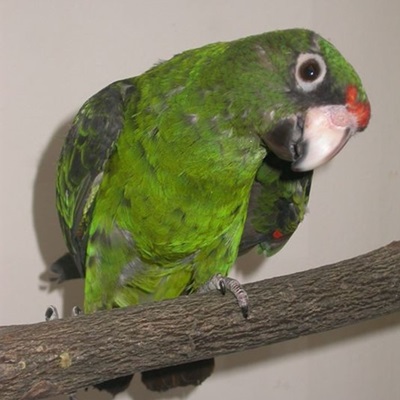
“I’ve gotta fly!” It’s the last day of January and our first Animal of the Month for 2024 needs to fly out of the spotlight to make way for our upcoming featured creature for February. Now that we have expanded our Animal of the Month reach, we hope that you enjoyed following our posts on “X” (a.k.a. Twitter) and on our new Threads account! If you happened to miss any of our posts on either social media platform, you can always find a summary of them right here on our blog. Did you know?:
- Red-fronted parrots (Poicephalus gulielmi) are endemic across a wide swath of central Africa, stretching from the west to the east.
- Red-fronted parrots are found in either all or parts of countries that include (but are not limited to) Côte d’Ivoire, Ghana, Cameroon, Gabon, Angola, the Democratic Republic of the Congo, Kenya and Tanzania.
- In much of their natural range, red-fronted parrots live in lowland rainforests. But their habitats can vary depending on the country in which they live.
- The wild red-fronted parrots of Kenya and Tanzania can be found at upper elevations of between 1,600 and 3,250 metres (5,249-10,662 feet) above sea level in coniferous (Podocarpus and Juniperus) forests.
- Wild red-fronted parrots can also be found living in coffee plantations in Ghana and Angola.
- Red-fronted parrots are also commonly known as Jardine’s parrots after Scottish naturalist and ornithologist Sir William Jardine.
- Jardine first described the red-fronted parrot in 1849 after his son, who was also named William, brought one of the birds home from the Democratic Republic of the Congo after three years of travels.
- The second part of the red-fronted parrot’s scientific name “gulielmi,” which is the species name, means “William” in Latin.
- Red-fronted parrots are a stout, medium-sized parrot species, with adults growing to approximately 25-28 cms (10-11 inches) from the tops of their heads to the tips of their tails.
- Red-fronted parrots are actually mostly green. They have orangey-red feathers on their foreheads, thighs and the carpal edges (or leading edges) and bends in their wings.
- The chest and underparts of red-fronted parrots are a brilliant green. Bits of black in the plumage gives the appearance of their heads being a slightly darker green compared to their chest and underparts.
- Much of the upper part of the red-fronted parrot’s beak is ivory-coloured while the tip is black. The bottom part of the beak is dark grey.
- Red-fronted parrots have short, square, black tails. The feathers on their wings and backs are black and edged with green, giving them a scalloped look.
- It can be difficult to tell the difference between female and male red-fronted parrots by sight alone as their plumage is very similar to one another.
- The irises in their eyes are slightly different in colour depending on the sex of the bird. Male red-fronted parrots have reddish-orange irises, while their female counterparts have orangey-brown irises.
- While much of their diet in the wild is plant-based, red-fronted parrots are omnivores. That means they eat both plants and animal matter.
- Wild red-fronted parrots will eat flowers, seeds, seed pods, wild olives, insects and a variety of palm fruits including oil palm (Elaeis guineensis), which is the main source of palm oil used in a wide range products that we consume and use.
- As social birds, red-fronted parrots in the wild can typically be seen in small flocks of up to about 10 or so birds. But in areas of food abundance they will happily forage with a much larger flock three or four times that size.
- Depending on food availability, red-fronted parrots may make lengthy day trips to forage. But they are resident birds and not considered to be migratory as they don’t seasonally leave their breeding grounds.
- Red-fronted parrots in captivity are known to be friendly, playful and affectionate. They are also very intelligent.
- While they are not famous for their talking ability, red-fronted parrots can mimic human speech and noises that they hear in their living environment.
- Red-fronted parrots love human attention, but are not demanding of it. They’re generally more independent compared to some other bird species commonly kept in captivity; such as African greys, cockatoos and Amazon parrots.
- If given lots of toys, red-fronted parrots in captivity can stay busy and keep themselves entertained for a bit of time.
- Red-fronted parrots are a long-lived species and most can live up to 30-40 years in captivity.

